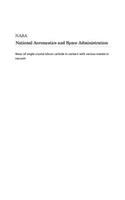
Wear of Single-Crystal Silicon Carbide in Contact with Various Metals in Vacuum
Series:
Sliding friction experiments were conducted in vacuum with single crystal silicon carbide (0001) surface in contact with transition metals (tungsten, iron, rhodium, nickel, titanium, and cobalt), copper, and aluminum. The hexagon shaped cracking and fracturing of silicon carbide that occurred is believed to be due to cleavages of both the prismatic and basal planes. The silicon carbide wear debris
NaN
VOLUME
English
Paperback

Sliding friction experiments were conducted in vacuum with single crystal silicon carbide (0001) surface in contact with transition metals (tungsten, iron, rhodium, nickel, titanium, and cobalt), copper, and aluminum. The hexagon shaped cracking and fracturing of silicon carbide that occurred is believed to be due to cleavages of both the prismatic and basal planes. The silicon carbide wear debris, which was produced by brittle fracture, slides or rolls on both the metal and silicon carbide and produces grooves and indentations on these surfaces. The wear scars of aluminum and titanium, which have much stronger chemical affinity for silicon and carbon, are generally rougher than those of the other metals. Fracturing and cracking along the grain boundary of rhodium and tungsten were observed. These may be primarily due to the greater shear moduli of the metals. Miyoshi, K. and Buckley, D. H. Glenn Research Center NASA-TP-1198, E-9360 RTOP 506-16
Price Comparison [India]
In This Series
Bestseller Manga
Trending NEWS




















